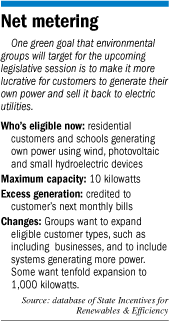Subscriber Benefit
As a subscriber you can listen to articles at work, in the car, or while you work out. Subscribe NowJudging by the hundreds of wind turbines sprouting in farm fields upstate, Indiana might appear progressive when it comes
to renewable energy.
After all, Indiana last year was ranked by the American Wind Energy Association as the fasting-growing
state in wind energy installation.
But looks are deceiving, with those turbines generating only a sliver of the
power the state’s electric utilities get from burning coal.
Wind—and photovoltaic—generation
by consumers of electricity is even more of a novelty in Indiana.
Environmental leaders hope that will change with
legislation in the upcoming session of the Indiana General Assembly that would provide more incentive for customers to generate
their own, clean electricity.
The Hoosier Environmental Council and Citizens Action Coalition see an expansion
of the state’s “net metering” policy as achievable during the short legislative session that starts Jan.
5.
Net metering requires electric utilities to credit consumers for electricity generated by a customer’s
wind, photovoltaic or other renewable generating device.
Indiana’s existing net metering rule is “appalling”
compared with other states’, said Jesse Kharbanda, executive director of the Hoosier Environmental Council.

Only systems producing less than 10 kilowatts qualify for net metering and then only residential and certain public
schools qualify. So there’s not much incentive to install bigger systems. And for those who qualify
under existing rules, the kilowatt limit means the systems have little benefit.
Other states
have markedly higher capacity limits, such as 150 kilowatts in Michigan, 40 in Illinois, 30 in Kentucky,
and 1,000 kilowatts in North Carolina.
Kharbanda said a higher limit would encourage more
businesses to install renewable energy systems. Growth in renewable energy would help the state better
deal with the cost of coming carbon regulations and steer the state further from coal-based generation.
Kharbanda
said he knows of one energy service contractor in the state that has 15 renewable energy projects drawn
up for clients who are waiting for a stronger net metering rule before committing.
Enhanced net metering legislation
was proposed during the last session in both chambers but died in committee. It included a measure by Sen. Sue Errington,
D-Muncie, that would have raised the cap to 100 kilowatts and would have broadened the types of eligible customers.
Last month, Sen. James Merritt, R-Indianapolis, chairman of the Senate’s utilities and technology committee, said
net metering would be a front-and-center issue for his committee during the upcoming session. He, Errington and Rep. Ryan
Dvorak, D-South Bend, are all said to be preparing new net metering measures for this session.
Unlikely to advance
during the short session is a so-called renewable energy standard, or RES, which environmental groups have unsuccessfully
pushed in the last five sessions.
An RES would require utilities to generate a certain percentage of their power
from renewable sources. Indiana is among 22 states without an RES and is conspicuously without one among Midwestern neighbors
such as Illinois, which has mandated that 25 percent of power come from renewables by 2025.
An RES could be a jobs
generator for the state because companies that manufacture renewable generation components tend to favor states with an RES,
Kharbanda said.
Last month when the Indiana Utility Regulatory Commission declared that regulated utilities should
put in place so-called demand-side management programs to produce a minimum 2-percent annual energy savings by 2019.
Demand-side management programs help customers reduce energy consumption, such as by using more efficient lighting. Many
electric utilities, such as Duke Energy and Indianapolis Power & Light, already have basic DSM programs in place.
Efficiency and renewable generation measures could drive utilities to seek legislation allowing them to recover lost revenue,
said Kerwin Olson, who heads energy policy matters at Citizens Action Coalition.
“It’s clear that utilities
are going to come in seeking some sort of cost-recovery, tracking-type bill,” he said.
That effectively would
rob consumer benefit from energy-efficiency measures, he added.•
Please enable JavaScript to view this content.
